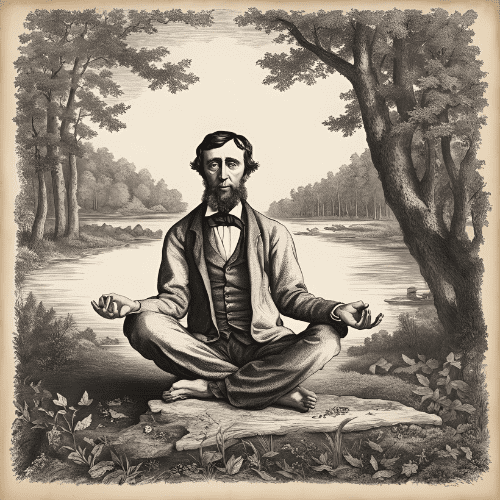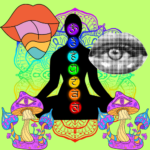

The framework of American acceptance of yoga and Vedic philosophy was almost built into the country’s formation as an experiment of democracy and newfound “religious freedom” that didn’t exist in Europe.
In the eighty-five years between the American Revolution and the Civil War – there was little time to figure out what it meant to be American. There was a strong idealistic need to prove that democracy could work; and because many of the colonies were founded by people seeking religious freedom from Europe’s institutions, spiritual experimentation was next on the list after political structure.
This era saw a surge of new religions (…or cults) that were left alone to do their own thing. Seventh Day Adventist (in which Kellogg thought cereal was the solution to physical health), Baptist, Mormon, Quakers, and many Christian offshoot religions ballooned during this era. Johnny Appleseed was planting trees as he traveled as a missionary for an obscure religion (that was strongly abolitionist). The Christian Scientist church was formed during this time, with a female founder who built principles off Vedic philosophy.
Mary Baker Eddy wrote, “The Science and Health with Key to the Scriptures” and you’ll notice with Kellogg and Eddy – a connection or fascination with physical health on equal, or even elevated ground than spiritual. Compared to European Christianity, it was a new spin to put physical health as a religious doctrine. Mary Baker Eddy pulled from several influences, but she heavily researched Ayurveda and Vedic texts and incorporated it into a Christian theology – making one of many new American religions.
In this era, Boston was the intellectual hub. It’s here that there was the most access to international trends and thought – both political and spiritual. Early American intellects – particularly Emmerson, Thoreau, and Whitman created an American voice by writing philosophically about nature. What isn’t as well known, is that these three and many more foundational American thinkers were heavily influenced by Vedic texts. In the 1840s Ralph Waldo Emmerson lectured that the ideas gaining traction in New England were “the very oldest of thoughts cast into the mould of these new times”.
Emmerson had been introduced to books about India and Vedic texts by his free-thinking aunt so by the time he graduated from Harvard Emmerson had read “numerous sources on the history, beliefs, and religious practices of India”. More than a hundred years before anything Vedic would be labeled as “hippy” Emmerson incorporated Vedic thought into much of his work through his career as one of the lead intellectuals in Boston. Many of Emmerson’s poems are adapted and Americanized from Vedic texts, and some of his more famous work is almost a direct translation from the Upanishads.
Without a yoga studio, ashram, palo santo, or psychedelics to turn to – Emmerson began an intellectual movement that focused on deep inner reflection in nature which became part of the yet unformed American philosophical identity. A hundred years later Ghandi would advise a follower to read Emmerson with the words, “The essays to my mind contain the teaching of Indian wisdom in a Western garb.” Emmerson’s interest and studies in Vedantic philosophy was passed on to his student, Henry Thoreau who would make these concepts even more popular, approachable, and distinguish an American inner search alone the wilderness as part of the quintessential American experience.
Thoreau’s most famous work, Walden’s Pond was centered on his cabin that he built on Emmerson’s property. Thoreau openly quoted and attributed Vedic texts in much of his work, including Walden’s Pond. Thoreau had come across the Bhagavad Gita while living in Emmerson’s home, and in later years collected a small library of Indian literature sourced through a British friend. In the words of scholar Alan Hodder, “the texts were a kind of touchstone for Thoreau’s own notations of personal asceticism and introspection. He had moments of euphoria and rapture in nature but he couldn’t really explain them until he started reading the Indian material. Then he actually saw references to what he was experiencing, and he thought, “I’m not the only one having this. There’s a long tradition to it.”” Thoreau was the first American actually call himself a yogi without the self-awareness that he was being basic.
Slightly later, Walt Whitman was the next naturalist poet to build off the Indian influence of what is now considered the base of the American Literature canon. Whitman studied Emmerson and Thoreau, and in Blades of Grass intentionally used Vedic philosophy adapted as an American mediation on the beauty of the simple. While Emmerson and Thoreau were more focused on accessing their own forms of introspection or meditation, Whitman took it a step further by connecting meditation in nature as a form of prayer. Poet Diane Ackerman explains Leaves Of Grass, “a sacred American texts about the need to forge ones own destiny, and the duty of all discover the world anew, by living in a state of rampant amazement at the endless pocket size miracles one encounters every day.”
From this foundation, American thought was launched even if the populace wouldn’t come across words like Dharma or Kharma until generations later. We see these themes every day as iconic American identity. One of the most common American stories is a man goes into the wild to find himself, and this was formed by the mystics of the east and adapted to conquer the frontier of the American West.


